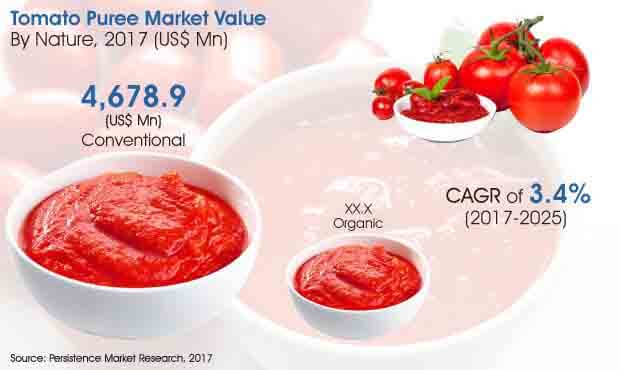Tomato Puree Market Segmented By Pouches, Glass, Jar, Tin, Bulk Packaging in Organic and Conventional Nature
Industry: Food and Beverages
Published Date: February-2018
Format: PPT*, PDF, EXCEL
Delivery Timelines: Contact Sales
Number of Pages: 256
Report ID: PMRREP22225
Tomato puree is prepared from tomatoes that are grounded, pressed, and blended to a soft creamy paste or thick liquid. Tomato puree is categorized as organic and conventional puree. Organic tomato puree is free from synthetic additives such as pesticides, chemical fertilizers, and dyes. It must not be processed under industrial solvents, irradiation, or genetic engineering. Its content should be 95% organic. Conventional tomato puree products are those that have been processed using any other food additives or mixed with any other suitable mixtures to form a product, prepared under good manufacturing practices (GMP guidelines).
The market analysis shows that conventional puree is currently more prevalent in the market. However, organic tomato puree market is expected to gain traction in the coming years. With people growing more and more health conscious with time, it is expected that the demand for organic products would increase. According to the market forecasts, organic tomato puree segment is expected to lead with respect to an exceptional growth rate of 8.4% during the forecast period. Conventional tomato puree still holds a higher market size and is expected to reach a market size of over US$ 5,800 Mn by the end of 2025.
Earlier, tomatoes were considered exotic products. But now, their easy availability has fueled the demand for tomatoes and use in various other products. Consumers have become habitual to tomato flavor and taste, and hence, other tomato products have also gained popularity. Apart from grocery retailers, many food chain owners are also infusing tomato puree into their recipes, like salads and beverages, with other traditional vegetable ingredients. Also, considering tomato puree’s wide scope of application in commercial foods and snacks, it is an added factor in fuelling the growth of the tomato puree market. The fondness for tomatoes has also triggered the use of tomato puree in many different products. Many soup manufacturers are blending tomato puree with vegetable soups, due to tomato puree’s natural sweetness and tangy flavor.
Carrot soup is very widely consumed in the U.S., and considering the demand for tomato puree only by the carrot juice industry, the demand for tomato puree in the U.S. is likely to increase. In the past few decades, the export of tomatoes has increased considerably. In order to cater to the consumer demand for tomato flavored products, there has been an increased sales for tomato-based ingredients like purees and concentrates.

European climatic conditions are not favorable for tomato cultivation. Despite the fact that Spain’s climate is not ideal for growing tomatoes, Spain probably has Europe‘s largest tomato plantations. However, Europe mostly relies on tomatoes imported from Asian countries such as India and China, and Middle Eastern countries such as Turkey. The import rate is higher as compared to the export rate in Europe for tomatoes and its different types of products (purees and concentrates).
The rise in import costs may lead to a hesitation growing among manufacturers towards production of tomato puree. The U.S. is largely dependent on the import of tomatoes from markets like Mexico. Despite high demand and popularity of the product, cost issues may hinder the trade and growth of the tomato puree market. The U.S. itself is not a big producer of tomatoes, and hence, the economic scenario may dampen the demand for tomatoes, leading to a decline or a very slow growth in the tomato puree market for an important region like U.S.
| Attribute | Details |
|---|---|
|
Based on Region |
|
|
Based on Packaging |
|
|
Based on Nature |
|
|
Based on Distribution Channel |
|
|
Based on End Use |
|
To know more about delivery timeline for this report Contact Sales
